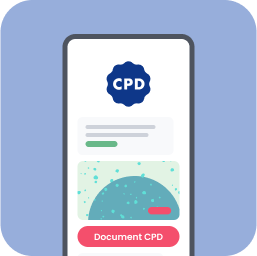In order to pass an audit, you need to complete a mandatory amount of hours or credits to comply with your Board's CPD registration standard.
What learning activities can count towards your CPD?
To ensure your learning activities contribute to your CPD requirements, they need to tick off four essential criteria.
If you can demonstrate that an activity…
- helps close a gap in your practice
- aligns with a learning need
- is something you can effectively reflect on
- is relevant to your context of practice
…then just about anything could be CPD (within reason)!
The most common forms of CPD are:
- Completing online educational resources
- Reflecting on feedback and keeping a practice journal
- Attending conferences and events
- Undertaking postgraduate course units which are of relevance to your context of practice
- Acting as (or working with) a preceptor, mentor or tutor
How should you choose which learning activities to complete?
In terms of which learning activities will most positively affect your practice, you need to take into account your own circumstances, the type of knowledge, skill or practice gaps you have, and where you want your learning to take you.
Your own circumstances
How do you learn most effectively? Are you an aural learner or a verbal processor? Understanding your learning habits is important because it makes your learning experience as efficient and satisfying as possible.
Additionally, how does your environment affect how you learn? If your break room is communal, perhaps reading articles is more effective than watching lectures. Or if you only have 5 minutes to yourself on any given day, maybe bite-sized pieces of learning (such as 4-min lectures or portions of courses) are a great way for you to engage with learning.
Knowledge gaps
Your learning activities shouldn’t just pertain to random topics picked on a whim. You need to make a conscious effort to identify any gaps in knowledge, skill, practice or even confidence or competency, and then direct your learning towards closing or narrowing those gaps.
To identify areas that you should focus on, speak with your direct managers. Their job is to keep an eye on what you need to work on and support you when you focus on improving those skills.
Future growth
After closing or narrowing knowledge and competency gaps, use your remaining CPD hours (and further time!) to develop and fulfil a professional growth plan.
Future growth learning can take the form of partaking in online leadership programs, receiving mentorship, creating collaborative reading groups or attending professional development seminars.
Why should you be careful about which learning activities you add to your portfolio?
Essentially, you need to make absolutely sure that the learning you’re completing (and recording in your portfolio) is relevant to (and enhancing) your practice.
This is absolutely integral because you can be audited at any time. During this audit, your registration Board (ie. if you’re a registered nurse your board is the Nursing and Midwifery Board of Australia) will review your up-to-date CPD portfolio to make sure that the learning you’re completing is relevant and of a high-quality. To learn more about audits, read 'What is an audit?'
What next?
Once you’ve read this article on what can count towards your CPD, return to the CPD Guide to find out more about your required professional development. We recommend reading ‘How much CPD do I need?’ next!

Looking for a smarter way to manage your CPD?
Make life simpler my earning and documenting your CPD all in one place.
View plans




